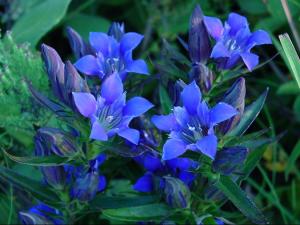Reduce your carbon footprint... Go native!
Submitted by Mayra on | Updated Tue, 27/06/2017 - 12:29

Conventional lawns are a net source of carbon dioxide to the atmosphere because of all the watering, fertilizing, mowing and pest eradication that go into maintaining those areas of turf grass. Landscaping with native plants, on the other hand, virtually eliminates those added sources of emissions while reducing air and water pollution, creating welcoming sites for birds and butterflies, and enhancing the beauty of your home, all at less cost than maintaining a lawn.
Impacts of conventional turf maintenance
According to the U.S. Environmental Protection Agency, 30% of the water used on the East Coast of the United States and 60% on the West Coast is used to water lawns. To calculate the carbon footprint of a lawn, we must consider the energy used by water utilities to treat the water before it reaches homes. Not to mention the 200 million gallons of gasoline used by lawnmowers every year. Or the energy required to manufacture the 70 million pounds of pesticides and 3 million tons of fertilizers applied annually to lawns in the U.S., and the greenhouse gases they release once applied.
University of Florida professor Pierce Jones has calculated that maintenance of 1,000 square feet of lawn - which is typical for a U.S. home - would release 29 pounds of CO2 due to fertilizer use, 15 pounds due to mowing, and 1 pound from pesticide use. Using EPA and U.S. Energy Information Administration data on home water use in the U.S., energy used for water treatment, and CO2 emissions from energy generation we can estimate that watering a lawn in the average home may release between 80 and 137 pounds of CO2 depending on whether the energy used by the public water utility comes from natural gas or from coal. That means maintaining a typical lawn releases about 125 to 182 pounds of CO2 per year. If that still doesn't sound too bad, consider that the same 1,000 square feet of turf only store about 68 pounds of CO2 per year.
The benefits of native plants
Once they are well established, native plants with their very deep root systems can usually live on rainfall and rarely need additional watering, which is the biggest source of CO2 emissions. Also, they generally do not need fertilizer, and would rarely need any pesticides because they are much better adapted to local growing conditions and regional pests than introduced plant species. And since you don't need to mow them every two weeks like you would turf grass, another source of CO2 is eliminated.
Finding and growing the plants that are right for your area
To find out about plants that are native to your region, see the native plant database maintained by the Lady Bird Johnson Wildflower Center at the University of Texas at Austin, which contains native plant information for the U.S. and Canada http://www.wildflower.org/plants, as well as lists of recommended species http://www.wildflower.org/collections. The EPA has useful advice on green landscaping with native plants http://www.epa.gov/greenacres/nativeplants/factsht.html, as does the U.S. Forest Service http://www.fs.fed.us/wildflowers/nativegardening/instructions.shtml. One thing to keep in mind is that native plants need to spend time developing deep roots, and therefore do not reach their full splendor in their first year. Also, it is important to buy seeds from commercial producers in your region, instead of collecting plants or seeds in the wild, which can deplete the resource. But with a little knowledge and patience, you can grow a beautiful landscape of native plants that will be gentler on the environment and save you time and money.
You will save the Earth by sharing and/or tweeting (corny right?)





